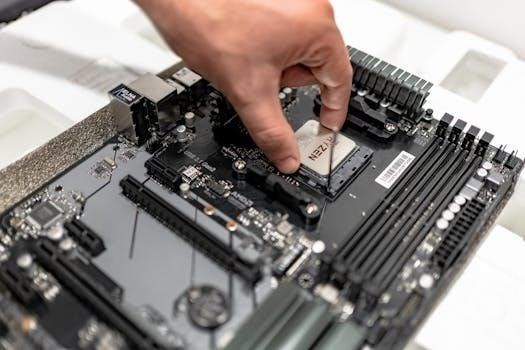
RT-385A Installation Overview
The RT-385A is a solid-state TSOd NAV/COMM transceiver, frequently used in general aviation․ It features an electronic digital frequency display․ This unit is considered a budget-friendly option for adding NAV/COMM, especially for 28-volt systems, though reliability may be a concern due to its age․
The RT-385A, manufactured by ARC Avionics Division, Cessna Aircraft Company, is a panel-mounted NAV/COMM transceiver designed for general aviation use․ This model stands out with its solid-state design and a digital frequency display, offering a more modern interface compared to older analog units․ As a TSOd (Technical Standard Order) device, it meets specific performance and safety standards․ Primarily used in aircraft with 28-volt electrical systems, the RT-385A is often considered an economical option for adding or replacing communication and navigation capabilities․ However, it’s crucial to acknowledge that these radios are becoming older, and their long-term reliability may be compromised․ For those seeking a more dependable alternative, the TKM MX-385 is frequently recommended as a directly interchangeable option․ The RT-385A installation involves integrating the unit into the aircraft’s existing systems, and ensuring correct wiring and mounting, as detailed in the installation manual․ Users should be aware of the specific serial number applicability, as it affects which installation manual is appropriate․
Key Features of the RT-385A
The RT-385A boasts several key features that make it a notable NAV/COMM transceiver in general aviation․ Its solid-state design contributes to its durability and performance, while the electronic digital frequency display enhances usability․ The unit’s compatibility with 28-volt electrical systems makes it an accessible choice for many aircraft owners looking for cost-effective solutions․ The RT-385A integrates both navigation and communication functions into a single unit, streamlining the avionics setup․ This transceiver is designed for panel mounting, simplifying installation․ Although older, it remains popular due to its relatively straightforward operation and the availability of installation and service manuals․ It’s important to note that while the RT-385A offers essential functions, potential users should consider its age and how this may impact its reliability, particularly when compared to newer alternatives․ The availability of specific installation manuals, depending on the unit’s serial number, ensures proper integration into the aircraft․

Installation Manual Details
Detailed installation manuals for the RT-385A are crucial for proper setup․ These manuals, often identified by part number CERT385A-82-IN, are available for download and are necessary for correct installation․
Availability of Installation Manuals
Finding the correct installation manual for the RT-385A is essential for a successful and safe setup․ These manuals are typically available in digital formats such as PDF, often accessible through online avionics resources or parts suppliers․ Several sources provide these documents, including websites specializing in aircraft parts and avionics documentation․ It is important to verify that the manual matches the specific serial number of your RT-385A unit, as there are variations based on production batches․ Some online platforms offer both free downloads and options to purchase physical copies or digital media like CDs or USB drives․ Ensure the manual you obtain is the correct version, as indicated by the part number and serial number applicability․ Always prioritize obtaining the manual from a reputable source to ensure accuracy and completeness․ These manuals are crucial for correct wiring, mounting, and operation․
Specific Manual Part Numbers (CERT385A-82-IN)
The installation manual for the Cessna 300 Nav-Comm RT-385A is specifically identified by the part number CERT385A-82-IN․ This particular part number is crucial for ensuring you are using the correct document for your unit․ The CERT385A-82-IN manual provides detailed instructions for installing the RT-385A, including wiring diagrams, mounting guidelines, and other essential information․ This manual is essential for technicians and aircraft owners intending to install or service the RT-385A․ The manual, identified by this specific part number, is often available through various avionics suppliers and online resources specializing in aircraft documentation․ It’s very important to cross-reference this part number when searching for the installation manual to ensure compatibility with your device․ Obtaining this specific manual will help ensure a safe and correct installation process․ Many suppliers will list it under this part number, or a variant of it․
Serial Number Applicability (Below 40,000 and 40,000 and Higher)
The RT-385A installation manual’s applicability is segmented by the unit’s serial number, with a key distinction between units below serial number 40,000 and those at or above 40,000․ This differentiation is critical because there can be slight variations in design or components between these two serial number ranges․ The manuals are specific to each group․ For units with serial numbers below 40,000, a specific manual is required that covers the unique aspects of those earlier units․ Similarly, a distinct manual is designated for units with serial numbers 40,000 and higher․ This ensures that technicians are using the most accurate instructions for the specific version of the RT-385A they are working with․ Failure to use the correct manual could result in incorrect installation or maintenance procedures․ The serial number is crucial to ensure the correct procedures are followed․ Always check the serial number․

Installation Procedure
The installation process for the RT-385A involves mounting the unit securely and making proper electrical connections․ It is crucial to refer to the specific manual for the correct wiring diagrams and pinouts to ensure a successful installation․
Mounting and Connection Instructions
The RT-385A installation necessitates careful attention to both the physical mounting and the electrical connections․ Begin by ensuring the mounting location is appropriate within the aircraft’s panel, providing adequate space and accessibility for maintenance․ The unit is designed for panel mounting, typically utilizing a standard mounting tray․ Secure the transceiver using the recommended hardware, ensuring a stable and vibration-resistant installation․ Before proceeding to electrical connections, disconnect the aircraft’s power supply․ Following the correct wiring diagram specific to your aircraft is critical․ Double-check the pinouts on the unit and the mating connector to avoid any incorrect wiring that could lead to damage or malfunction․ Ensure the wiring is routed properly, avoiding any sharp edges or areas where it could be pinched or damaged․ Use appropriate connectors and wiring techniques․ A good ground connection is very important for the unit to work properly․ Confirm all connections before applying power․
Wiring Diagrams and Pinouts
The RT-385A installation requires precise understanding of its wiring diagrams and pinouts․ These diagrams are essential for connecting the unit correctly to the aircraft’s electrical system and other avionics․ Typically, the installation manual includes detailed schematics showing each pin’s function․ The diagrams will show connections for power, ground, audio, navigation signals, and communication signals․ It’s crucial to identify the correct pin for each function before making any connections․ The pinouts specify the exact location of each pin on the connector and their corresponding electrical characteristics․ These details are critical to avoid damaging the unit or other parts of the system․ Ensure that you use the correct wiring diagram that matches your specific RT-385A model and serial number range․ Incorrect wiring can lead to malfunction or damage to the unit, so always double-check against the manufacturer’s specifications․

Service and Maintenance
Service and maintenance details for the RT-385A are found in the service/parts manual․ This manual includes recommended service information and an illustrated parts list, crucial for maintaining the unit’s proper function over time․
Service/Parts Manual Information
The service/parts manual for the RT-385A, identified by P/N 007010439, is essential for maintenance and repair․ This manual is specifically applicable to units with serial numbers 40,000 and higher․ It contains critical information needed for servicing the Cessna 300 NAV/COM, type RT-385A․ This document offers recommended service procedures, detailed part lists, and illustrated guides․ It’s a key resource for avionics technicians working on this model․ The manual is updated periodically, with changes noted for specific dates, such as Change 1 in May 1986․ The availability of this manual ensures that technicians can properly maintain the RT-385A, extending its operational life and ensuring continued safe use․ Proper use of the manual helps to maintain the equipment in top operating condition․ It contains recommended service information and illustrated parts list applicable to the Cessna 300 NAV․COM type RT-385A․ This information is supplemented and kept up to date by the manufacturer․
Synthesizer Board Identification
The RT-385A utilizes distinct synthesizer boards for communication (COM) and navigation (NAV) functions․ It’s critical to identify these boards correctly for servicing and parts replacement․ For units with serial numbers up to 39,999, the COM synthesizer board is designated as A3A1․ The NAV synthesizer board has a different identification, which is important to note for accurate troubleshooting and repair․ For units with serial numbers 40,000 and higher, the board identification may differ, which is why consulting the correct service manual is vital․ Understanding the serial number breaks and associated board designations is essential to avoid incorrect parts installation or replacement․ The correct boards are essential for the radio’s proper function and frequency generation․ Accurate identification prevents any potential issues during maintenance or repair; This information is critical for maintaining the unit and ensuring its continued operation and reliability in the aircraft․
